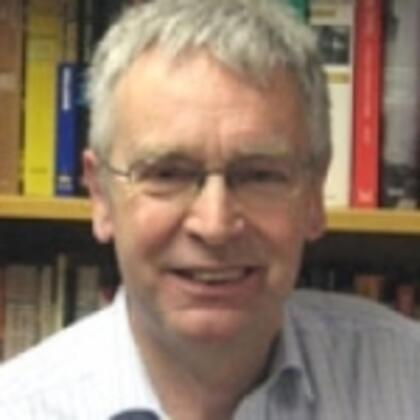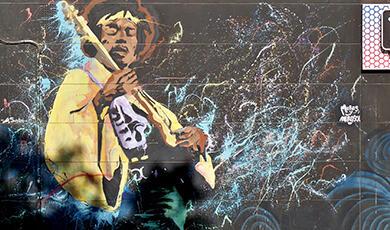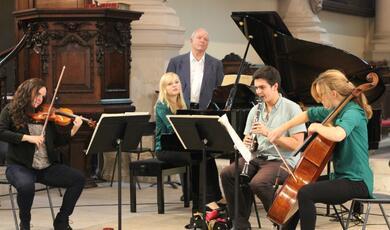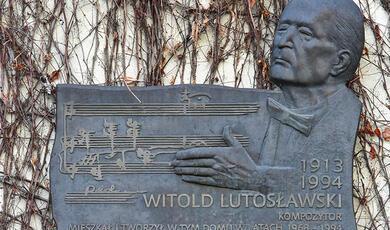Music in the Age of Copernicus
Share
- Details
- Text
- Audio
- Downloads
- Extra Reading
Kraków was one of Europe 's main cultural and commercial centres during the Renaissance. Who were its major musical figures and what were their roles in society? How did composers like Wacław of Szamotuły and Jan of Lublin connect to the cultural developments of Western and Southern Europe?
Download Text
Music in the Age of Copernicus
Professor Adrian Thomas
Introduction
Without doubt, the most famous Pole, apart from or alongside Chopin and Pope John Paul II, is Nicholas Copernicus, or Mikołaj Kopernik, to give him his Polish name. He was born in 1473, the year that the first printing press was established in Poland, and he died in 1543, when the Polish King founded the Rorantist Choir at the Royal Court on Wawel Hill in Kraków.
More is known about Copernicus's life than any Polish composer of the period. He was educated at the Jagiellonian University in Kraków, where he studied astronomy, philosophy, Latin and mathematics. Like many of his contemporaries, he went abroad to further his studies, in his case to Bologna (canon law, 1496-1500) and Padua (medicine, 1501). He then returned to Frauenberg (Polish Frombork), from whence he proceeded to contribute to civic society, being active for example in the the early stages of monetary reform in the 1520s. He had already begun to publish:Little Commentary appeared in 1514, and the following year he began what became his most famous work, De revolutionibus orbium coelestium, although it wasn't completed until the year of his death. As Norman Davies eloquently summed Copernicus's achievement: "His discovery, of the earth's motion round the sun, caused the most fundamental revolution possible in prevailing concepts of the human predicament". 1
Another major figure of our own times imagined Copernicus's discoveries thus:
MUSIC 1
Henryk Mikołaj Górecki Symphony 2 'Copernican' (opening)
What a magnificent, orbit-grinding sound that is! Later on in his Copernican Symphony, written to commemorate the 500th anniversary of Copernicus's birth, Górecki sets a sentence from De revolutionibus: "Quid autem caelo pulcrius, nempe quod continet pilcra omnia?" (What indeed is more beautiful than heaven, which of course contains all things of beauty?).
Many other features of Renaissance Poland testify to the country's significance on the European stage. There was a huge expansion in industry, transport and trade, of towns and the Jewish population. The Confederation of Warsaw proclaimed religious freedom in 1573 and in 1596 the Synod of Brześć (Brest-Litovsk) united the Orthodox Church with Rome. The Reformation and Counter-Reformation played a significant role, not least the consequences of the Council of Trent (1545-63), which removed many chants from the Roman Catholic liturgy. In cultural terms, this was Poland's 'Golden Age' (Złoty Wiek). In science and literature, especially in poetry, this is amply evident. But it is probably in its art and architecture that today, as non-Poles, we can best appreciate Renaissance Poland.
For example, the model city of Zamość in South-east Poland was laid out on the principles of Ciceronian harmony and fostered a high level of intellectual life. Like his compatriots Copernicus and the writer Jan Kochanowski (of whom more later), Jan Zamoyski who created Zamość was a model of the Renaissance man. As Norman Davies, again, has so astutely put it: "They were all striving towards conscious ideals of beauty and harmony. Copernicus was most concerned with the theoretical order of the universe, Kochanowski with the practical ordering of human emotions and belief, Zamoyski with political order". 2
Kraków
Central to any discussion of Renaissance Poland is its capital city, Kraków. Its position politically, culturally and in terms of national and international trade was unassailable. It also boasts, to this day (undamaged by 20th-century conflicts but increasingly damaged by industrial poluution), the most stunning architecture, such as the Sukiennice in the main square at St Mary's Church nearby. Here's the famous hejnał (trumpet call), still played from St Mary's tower as a symbol of Kraków's ability to survive foreign invasion.
MUSIC 2
Kraków hejnał
Polish Music and the Renaissance
We have to acknowledge that, because of the loss of artefacts in wars and occupations, notably in the 20th century, much of Poland's musical heritage from this period has been lost for ever. Nevertheless, the music which we can hear today is testament to its central role in Poland as a beacon of Renaissance thought, innovation and discovery. What survives, however, is by no means as extensive as that in France, Germany, Italy or the Netherlands. And it is likely that it was never quite as extensive as it was in these countries. The musical impetus and patronage, as elsewhere in Europe, came from the Court and the Church. And it is evident that Kraków and other Polish centres were remarkably up-to-date, as the import and export of musicians demonstrates: Heinrich Finck (1445-1527) came to Poland from Germany, Jakub Reys Polak (c.1540-c.1605) went to France, and Luca Marenzio (1553/4-99) visited Poland from Italy at the very end of the 16th century.
Among the early musical sources are theoretical musical writings. These may seem academic to us today, but they were, in the first days of printed materials on music, significant ways of sharing ideas. Sebastian z Felsztyn (born c.1480-90) was one such figure. He studied at the Jagiellonian University in Kraków in 1507-09 and was the author of a number of treatises, including Modus regulariter accentuandi lectiones matutinales prophetias necnon epistolas et evangelia (1518). Another figure was Jerzy Liban (1464-1546 or later).
Liban was of German origin, but regarded himself as a true Pole ('sermo patrium nostrum id est Polonus'). After studies in Kraków in 1494 he taught at St Mary's church school, becoming cantor then rector. He had characteristically broad interests, being a composer, music theorist, teacher, publisher, humanist and philologist (he was fluent in Greek, Latin and Hebrew). He published over ten texts, on philosophy, philology, history, medicine, law, theology and music. Among the musical ones wereDe accentuum ecclesiasticorum exquisita ratione (On the Exquisite Method of Ecclesiastical Accentuation, c.1539) and De musicae laudibus oratio(Oration in Praise of Music, 1540). His best-known composition is Ortus de Polonia (1501, published 1518).
MUSIC 3
Jerzy Liban Ortus de Polonia
Ortus de Polonia was dedicated to the Polish patron saint, St Stanislaus, whom we have encountered earlier in this series. It demonstrates stylistic links with the German school, especially in its use of note against note setting of the text (nota contra notam).
Sources and Collections
Much of the music that survives does so thanks to having been collected together, usually at the time but sometimes at a later period. So it is that tablatures in Warsaw (1528, 1520-30), Lublin (1537-48), Kraków (1548), Łowicz (1580) and Gdańsk (1591), for example, are crucial. These collections include liturgical music (masses, sequences, Latin hymns, hymn in the vernacular), secular vocal music, organ preludes, keyboard works, chansons, motets, drinking songs, etc.. One of the most important is the organ tablature of Jan z Lublina (John of Lublin), one of the largest in Europe from this period. It includes 36 dances that show off the secular and folk-related aspects of Polish life.
One of the composers featured in the Lublin manuscript is Mikołaj z Krakowa (Nicholas of Kraków). His dances typically start in duple time, then for the second part shift to triple. This is undoubtedly related to the Italian combination of pavane (which travelled across Europe very quickly after it appeared in 1508) and the livelier saltarello or galliard (which had 14th-century origins). An excellent example is Szewczyk idzie po ulicy szedełka nosząc (The cobbler goes through the streets carrying his awls).
MUSIC 4
Mikołaj z Krakowa Szewczyk
On that recording, there was a surprise appearance of a 'cymbal' organ stop in the second section (organs of the period had features that we tend now to associate with the fairground variety).
Another piece by the same composer shows Hungarian origins. Thehajducki became popular after 1500 and was a lively solo dance, usually for men to show how 'fit' they were! You may note the folky chord alternation (G-F) in the second half of each of the two sections. This version reinstruments the dance from organ to sopranino recorder, tenor and bass violas da gamba, drum and lute.
MUSIC 5
Mikołaj z Krakowa Hajducki
Many tablatures uncluded pieces by foreign composers, and so we can tell a great deal about how music developed across Europe. In Polish collections there are pieces from Italy, Germany, France and the Netherlands by such as Janequin, Josquin des Pres, Palestrina, di Lasso (Lassus) etc.. In Lublin, for example, there are transcriptions of Josquin'sPlus mille regres, Verdelot's Madonna bella and motets by Senfl, Isaac and Josquin. Here's a song by Pierre Sandrin (1490-1561), played on a clavicytherium, an instrument known to have been created sometime in the 1460s. It looks rather like a 'giraffe' piano and the instrument on this recording, which is in the possession of the Royal College of Music in London, dates from 1480. Note the decorative, improvisatory style of the transcription.
MUSIC 6
Pierre Sandrin Doulce memoire
Wacław z Szamotuły (born after 1520, died c.1560)
Wacław of Szamotuł came from near Poznań, moving to Kraków for his studies. The first time that he appears in commentaries - in the writings of Szymon Starowolski (1588-1656), some considerable time after his death - is in information that he studied music, law, mathematics, Aristotle, and that he wrote poetry and was fiercely patriotic. In 1547-55 Wacław was a court composer at Wawel. The Reformation movement influenced him around 1550 and he moved to the Calvinist court of Mikołaj Radziwiłł Czarny in Lithuania. He was the first Polish composer to have his music printed abroad, although very little of his output survives. Most of this is in Polish (evidence of his and other Polish composers' move towards setting texts in their own language).
The striking characteristic of Szamotuł's music is the new homophony, with just a gentle hint of counterpoint. The idiom is clearly diatonic rather than modal, with cadences and modulations. Here's a setting of Psalm 1Blessed is the Man, in a version by one of Poland's most distinguished poets of the mid to late 16th century, Andrzej Trecieski.
MUSIC 7
Wacław z Szamotuł Błogosławiony człowiek
The lilting 3/4, dance-like idiom of Błogosławiony człowiek is joyous, not solemn. The eagle-eyed (and eared) will note the variable F/Fsharp that typifies much Renaissance music and demonstrates the transition between modality and tonality.
In a second piece by Wacław of Szamotuły, Modlitwa, gdy dziatki spać idą(Prayer for children going to sleep), another feature of Renaissance music becomes apparent. This is the use of the tenor part to provide an anchor for the faster movement in the other voices. Here, it does not have thematic consequences, but elsewhere, as we shall see, it often does. 3The Prayer is a particularly eloquent song, almost madrigalian in texture. It too has a text by Andrzej Trecieski:
"Already dusk is falling, night closes in,
Let us beseech the Lord for help,
To be our guardian,
To protect us from wicked devils,
Who especially under cover of darkness
Profit from their cunning."
Among its memorable moments is the triadic motif at 'To be our guardian' and, interestingly, the sweet thirds at 'wicked devils'.
MUSIC 8
Wacław z Szamotuł Modlitwa. gdy dziatki spać idą
My final example from this fine composer is his setting of Psalm 116Alleluia. Chwałcie Pana Boga. This is another extraordinarily dance-like setting of the Laudate Dominum text, marking the continuing secularisation of sacred music. The metre switches from threes to twos and back, invigorating what is actually a plain homophonic texture. Why should this be? It is because the words dictate the rhythm and therefore the musical discourse (a process which would come to full fruition at the start of the 17th century).
A word is due here about the author of the Prayer. This was one of the foremost Reformation writers in Poland, Mikołaj Rej (1505-69), the 500th anniversary of whose birth was celebrated last year. Rej converted to Calvinism in the 1540s and was the first major Polish writer to quit Latin for the vernacular: "Poles are not geese;" he wrote, "they have their own language". His reputation now rests mainly on his satirical writings on Polish society such as his A Short Debate between Three Persons: a Nobleman, A Bailiff and a Priest published in the year that Copernicus died (1543). He also wrote a prose paraphrase, from the Latin, of the Psalms of David (1546).
MUSIC 9
Wacław z Szamotuł Alleluia. Chwałcie Pana Boga
Music and the Royal Court
This is perhaps a suitable moment to outline the context provided by the royal court and the succession of kings who dominated the Polish Renaissance. The reign of King Jan Olbracht (1492-1501) was followed briefly by that of his brother, the Grand Duke of Lithuania. The first major reign of the 16th century (1506-48) was that of a second brother, King Sigismund I Stary (Old) whose Italian wife, Bona Sforza, was a major player in the developing internationalism of Polish culture (and she also reputedly introduced vegetables to the Polish kitchen!). King Sigismund II Augustus, who was crowned as his father's successor in 1529, succeeded to the throne in 1548, reigning until 1572. He it was who united Poland with the Grand Duchy of Lithuania, creating the Commonwealth (Rzeczpospolita) in 1569. As far as the tolerant Sigismund II was concerned, he was the 'King of all Poles', viewing his domain as 'a country without stakes'. Furthermore, his enlightened self-assessment was: "I am King of the literature, not of their consciences". Unsurprisingly, Sigismund fostered Polish literature, music and painting as well as deepening his country's links with foreign artists and culture.
The Royal Court was located at Wawel Castle, built on a large rocky outcrop to the south of the central square in Kraków and on the banks of the Vistula River. Among its treasures is the Sigismund Chapel, designed by Bartolomeo Berrecci. Sigismund I endowed this chapel with a choir whose duty it was to sing polyphonic music perpetuis futuris temporibus. The tradition last for over two centuries, and the Rorantist Choir nurtured Polish composers and performers throughout its long existence. There were, of course, occasions which demanded ceremonial music, such as my next two examples, both of which illustrate the symbiotic nature of nationhood and culture.
In 1547, Sigismund II married for the second time. His new wife was Barbara Radziwiłł and this anonymous Pieśń o weselu najaśniejszego Krola Sygmunta wtórego (Song on the Wedding of his Majesty King Sigismund II) was published in 1553. It has 18 quatrains (we'll just hear the beginning!) and the composer has borrowed his tenor line from an earlier ceremonial piece, Pieśń o elekcji (1529). Once again, there is a Góreckian connection - he borrowed the tenor for the finale of his Three Pieces in Old Style (1963).
MUSIC 10
anon. Pieśń o weselu najaśniejszego Krola Sygmunta wtórego
A companion piece, rather tragically, marks the death only four years after her wedding of Queen Barbara (some suggest that her mother-in-law, Bona Sforza, poisoned not only her but her predecessor too). Barbara wanted to be buried in Vilnius in Lithuania. Sigismund, in deep mourning, followed her coffin for four weeks as it travelled from Kraków: "He accompanied the coffin on horseback, sometimes on foot, crossing his vast kingdom, dressed in black garments, exhausted, retired into his shell of despair. [The song] is dominated by elegiac mood, its tune is full of lyrical softness and melodiousness …" 4
This Epitaph on the Tomb of the Virtuous Queen Barbara Radziwiłł - 42 quatrains long - has immense expressive power, despite its panegyrical text:
You that would know
what body rests in this narrow tomb,
pause a while,
it needs little time.
I am the renowned Barbara,
first wife of Gastolt; [Gastolt died, leaving Barbara a widow]
God bore me in mind -
he destined me to be a great queen.
I came of an honourable stock,
the house of Radziwiłł;
my father was a great commander,
he brought me up with all befitting care.
I became a great queen,
attained the crown, a great prize,
of the famous State of Poland
together with the Duchy of Lithuania.
MUSIC 11
anon. Napis nad grobem zacney Krolowey Barbary Radźiwiłowny
Lute Music
At the opposite end to the spectrum of this public mourning is instrumental music, particularly that for a solo instrument. In the first half of the 16th century it was the lute that held the position of 'queen of instruments', and King Sigismund II's tomb has the sculpture of a lute in a prominent position. Its image had appeared in Polish art since the early 1400s, but it was in the 16th century that its poential for creative and instrumental virtuosity was fully realised. Jakub Reys Polak, whom I mentioned earlier, was court lute player to the French kings Henry III and IV, Diomedes Cato, born in Venice c.1570, made his career in Poland, and there was also the Polish composer Wojciech Długoraj (c.1557 to after 1619). Perhaps the greatest of them all was Valentin Bakfark (1507-76), a lute-player and composer of Hungarian origin. In 1549-66 he was court musican for Sigismund II, who knighted him, and his music has been preserved in the tablature Harmonarium musicarum in usum testudinis factarum, tomus primus, published in Kraków in 1565. To judge from a delightful little epigram, O Bekwarku, from Jan Kochanowski (of whom more shortly), there was no-one to beat Bakfark in Poland:
If the lute knew how to speak
She would with her voice say:
All you others, play on the bagpipes,
Let me have Bakfark!
Czarna krowa (The Black Cow) is one of Bakfark's best-known pieces. Like works in other tablatures, this is an instrumental arrangement of a Polish song and is presented as a set of variations. It is elegant, with a strange descending sequential conclusion, like a sort of chorale.
MUSIC 12
Valentin Bakfark Czarna krowa
Simple Hymns
The competing musical claims of the Reformation and Counter-Reformation meant that we may find in sacred music both masses glorying in full polyphony - such as the Easter mass Missa paschalis by Marcin Leopolita (d. 1589) - and much simpler choral pieces with a wider circulation than the high-powered Rorantists on Wawel hill. The masterpiece of this latter genre is a setting of the psalms, published in Kraków in 1580, but first I need to sketch in the background of how their Polish versions came into being.
I have mentioned the name of Jan Kochanowski a couple of times already, and he it was who penned this biblical paraphrase of the psalms. Kochanowski (1530-84) was the founder of Polish verncular poetry, comparable to Ronsard in France (1524-85). His Song 25 is regarded as his manifesto:
What do you want from us, Lord? Your countless
Gifts and Your benificence are boundless.
The church does not contain You; everywhere,
In heaven, earth, sea, the depths, You are there.
…
You built the whole world and the sky we see,
With stars You embroidered it beautifully.
For immense earth You laid the foundation
And dressed with herbs Your naked creation. …
Kochanowski published his Psałterz Dawidowy in 1579. It was translated from the Latin, not from the Hebrew, and not from the Vulgate but from an earlier version by the Scottish humanist George Buchanan, whosePsalmorum Davidis paraphrasis poetica appeared in London in 1566. It can be seen, therefore, that the Book of Psalms was very much at the centre of literary attention in the period, and Kochanowski's Polish-language version had great impact in Poland. He wrote to the Bishop of Kraków in his foreword that he had "climbed the rock of beautiful Calliope" holding "David's golden fiddle". And the expression of private piety, within the context of epic poetry with its references to antique poetic idioms and versification, was characteristic. While you may not find English translations of Psałterz Dawidowy, you may come across translations of his powerful Treny (Threnodies), published a year later in memory of his daughter Orszula.
But we do have access to Kochanowski's psalms through the musical setting by his compatriot Mikołaj Gomółka (1535 to after 1591). At the age of ten Gomółka had become a page-singer in Wawel, subsequently becoming a royal trumpeter then a member of the fistulatores (woodwind players). He left Kraków in 1563 and returned to his home town of Sandomierz. From 1591 he was employed in the Kraków court of the Polish Chancellor, Jan Zamoyski, the creator of Zamość.
The combination of vernacular language and Polish music in Gomółka'sMelodie na Psalterz polski (Melodies for the Polish Psalter) is a feature of Renaissance Poland, especially as Gomółka largely eschewed complex polyphony in favour of short, syllabic and stanzaic constructions - matching Kochanowski's verse. Gomółka commented that the Melodiesare "indeed easy in the performance, without let or hindrance to the plain man", that they are written "for the Poles, for our simple folk". Indeed, there are hints (for example, nos. 47 and 103) of popular dance, perhaps even of the mazurka. I am going to close today by discussing three of the psalms that stand out for their originality.
Psalm 45b My heart overfloweth with a goodly matter has the same textual source as My Heart is Inditing, made famous in settings by Purcell and Handel. It is worth comparing the version familiar to us from theBook of Common Prayer with that of Kochanowski. For my money, as in all my examples, Kochanowski has the expressive edge.
My heart is inditing of a good matter:
I speak of the things which I have made unto the King
My tongue is the pen of a ready writer. (BCP)
My heart is inditing unto its Lord
And my tongue, obedient to my full heart,
Takes the words and spells a new rhyme
like the pen of a ready writer. (Kochanowski)
Gomółka's setting is mostly homophonic, with a final verse marked by a striking rising sequence followed by a cascade of quavers as if indicating a flow of inspiration.
MUSIC 13
Mikołaj Gomółka Psalm 45b
In contrast, Psalm 81 Sing aloud unto God our strength achieves an extraordinary metric fluidity combined with a dancing rhythmic kick, appropriate joyfulness for an evocation of timbrel, psaltery and trumpet!
MUSIC 14
Mikołaj Gomółka Psalm 81
To conclude, we turn to Psalm 137 By the rivers of Babylon. Again, a comparison between the Book of Common Prayer and Kochanowski's version is instructive:
By the waters of Babylon we sat down and wept:
when we remembered thee, O sion
As for our harps, we hanged them up:
upon the trees that are therein. (BCP)
Sitting by the low banks of the waters of Babylon
and remembering Thy fair towns, O Sion,
what can we do save sadly weep,
our harps hung upon the willow trees in the midst thereof. (Kochanowski)
Psalm 137 is one of the most expressive in the set, notable for its low tessitura, homophonic texture, and the telling false relations between C natural and C sharp.
MUSIC 15
Mikołaj Gomółka Psalm 137
With the music of Gomółka ringing in our ears, we leave the Polish Renaissance at one of its highpoints. There was more typically courtly music of a secular nature, often composed by foreign visitors like Marenzio, but for that and the sudden change of direction that music took in the early years of the next century, not only in Poland but elsewhere, we will have to wait until our next meeting!
1. Norman Davies, God's Playground, vol.1, p.150
2. Davies, p.152
3. There is another Górecki connection here, because he has used this same tenor line in several of his own compositions, notably Old Polish Music (1969) and the First String Quartet, subtitled 'Already it is Dusk' (1988).
4. Ewa Obniska in the booklet for 'Muzyka na Wawelu' (DUX 0216)
© Professor Adrian Thomas, Gresham College, 23 February 2006
This event was on Thu, 23 Feb 2006
Support Gresham
Gresham College has offered an outstanding education to the public free of charge for over 400 years. Today, Gresham College plays an important role in fostering a love of learning and a greater understanding of ourselves and the world around us. Your donation will help to widen our reach and to broaden our audience, allowing more people to benefit from a high-quality education from some of the brightest minds.


 Login
Login







